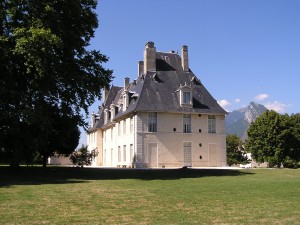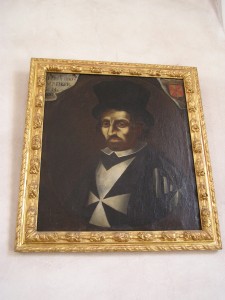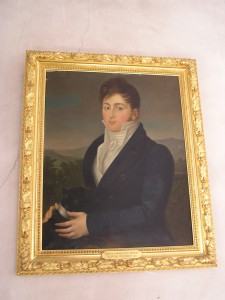Further to my previous article, a host of ‘bonnes dames’, or fairies, seem to have survived the Christianisation of Gaul, continuing, in the imagination of superstitious locals, to haunt their grottos and springs.
Thanks to her association with the mighty Lusignan family and to the popularising of her legend by Jehan d’Arras, Mélusine is the name that has been given to many of them by default. At least three other great families claim descent from her (though Proust, who was clearly fascinated by the legend, adds a fictional fourth, the Guermantes), namely the Luxembourgs, the La Rochefoucaulds and the Sassenages.
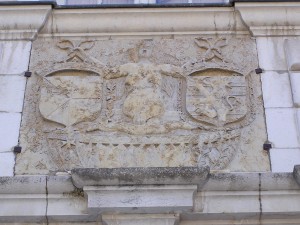
Mélusine in her bathtub above the main entrance to the Château de Sassenage. The gyronny device to the left is of Bérenger, whilst the bars and lion to the right are of Sassenage. Identical arms were borne by the Lusignans and Luxembourgs.
Kinship with the Lusignans is suggested in their heraldry. All four bear for arms barry of ten argent and azure. The Lusignans, Luxembourgs and Sassenages have each added a red lion rampant with a golden crown, tongue and claws, whilst the La Rochefoucaulds superimpose three chevrons, that in chief couped, gules. Delightfully, there is a Mélusine de La Rochefoucauld in our own time, born in 1996.
The Sassenages, actual offspring of the counts of Lyon and Forez in the tenth century, were rooted far away from Lusignan in the Dauphiné, and took their name from the lordship of Sassenage, near Grenoble. As at La Rochefoucauld, there are impressive grottos nearby that Mélusine was said to inhabit, although she was said to emerge from the grottos of Sassenage, in dignified human form, three days before the death of the seigneur, as an obliging premonition (Léo Delaivre, Mère Lusine ou Mélusine dans la littérature et les traditions populaires, Arbre d’Or, Geneva, 2004, p.85).
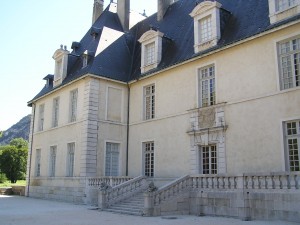 It seems likely that the Sassenages had always claimed descent from the local fairy of the grotto, but that it was only after acquainting themselves with Jehan d’Arras’s work that they had attributed to her the name of Mélusine. The accepted version of events was that Mélusine must have fled from Lusignan to the Dauphiné, to re-marry there after the death of Raymondin and to found the line of Sassenage (Delaivre, Mère Lusine, pp.99-100). It would be interesting to know when they first adopted the arms of Lusignan, but that information is not to hand.
It seems likely that the Sassenages had always claimed descent from the local fairy of the grotto, but that it was only after acquainting themselves with Jehan d’Arras’s work that they had attributed to her the name of Mélusine. The accepted version of events was that Mélusine must have fled from Lusignan to the Dauphiné, to re-marry there after the death of Raymondin and to found the line of Sassenage (Delaivre, Mère Lusine, pp.99-100). It would be interesting to know when they first adopted the arms of Lusignan, but that information is not to hand.
The Château de Sassenage was built in the 1660s, in white dauphinoise stone, close to the ruins of the medieval fortress. In a carving above the main entrance, Mélusine is depicted in her bathtub, alongside the arms of the Sassenages and the Bérengers. The family motto proudly asserts: Si fabula, nobilis illa est – ‘A legend, perhaps, but a noble one’.
The château today, though crammed with family treasures and a rich archive, is a rather forlorn place, left to the care of the ever-penurious Fondation de France in 1971 by the widow of the last Marquis de Bérenger-Sassenage. The adjacent suburb is singularly unlovely and has the desperate air of a zone artisanale. The once-magnificent park is maintained, but otherwise neglected. The house itself seems fossilised, a little cobwebby, apparently unrenovated in years (apart from the kitchen, where work is currently in progress), and peopled only by the spectral, sometimes alarming images of former Sassenages. Guided tours are offered by a courteous and knowledgeable curator.
Read my previous article on Mélusine at http://www.rupertwilloughby.co.uk/gleanings/the-legend-of-melusine-how-the-tutelary-fairy-of-the-lusignans-came-to-reign-over-starbucks/.
